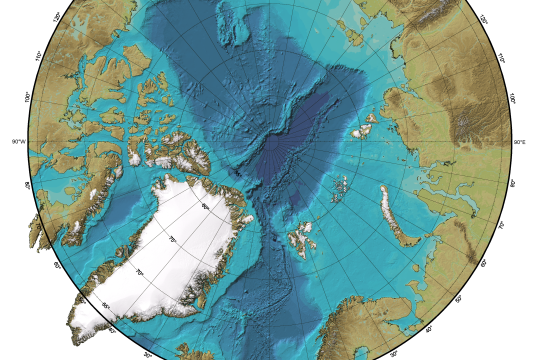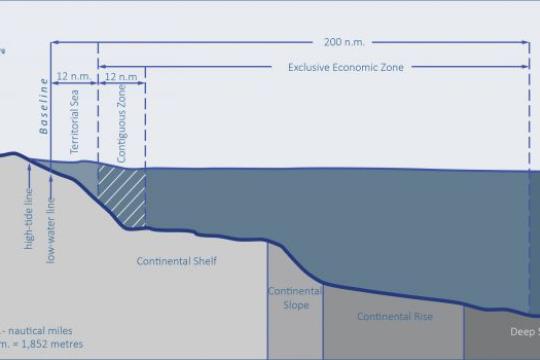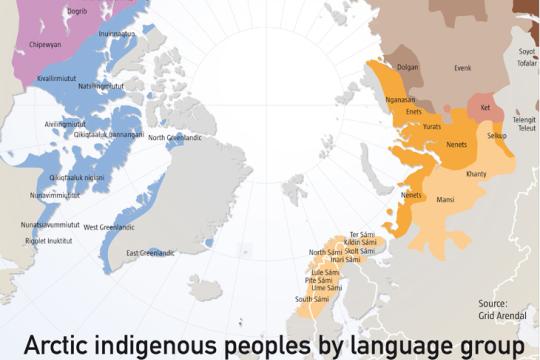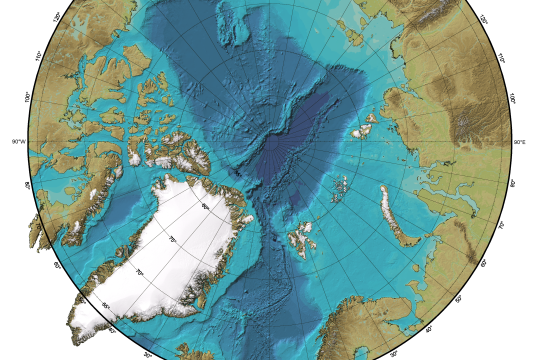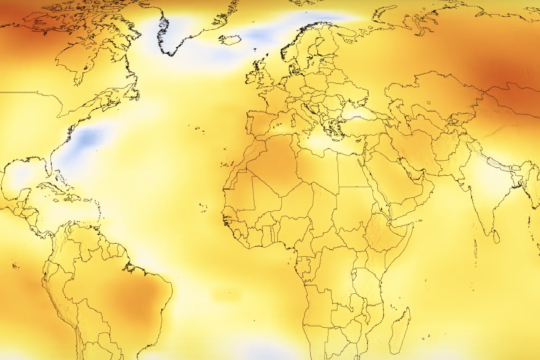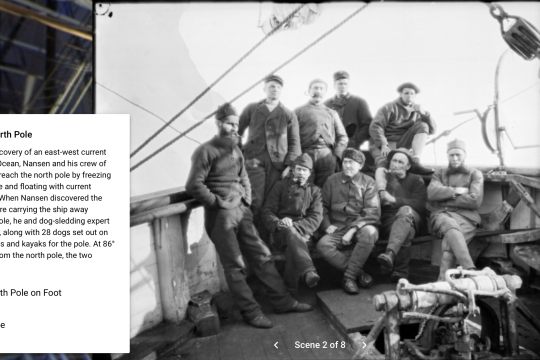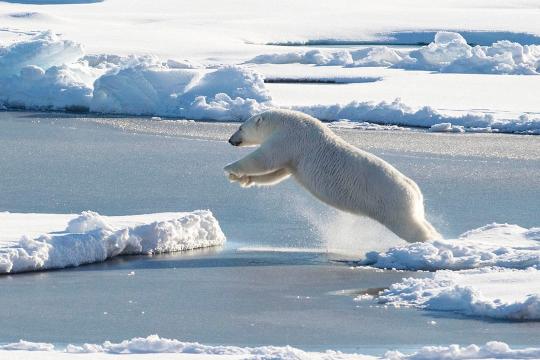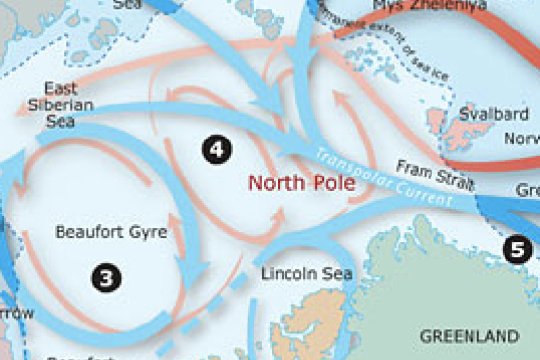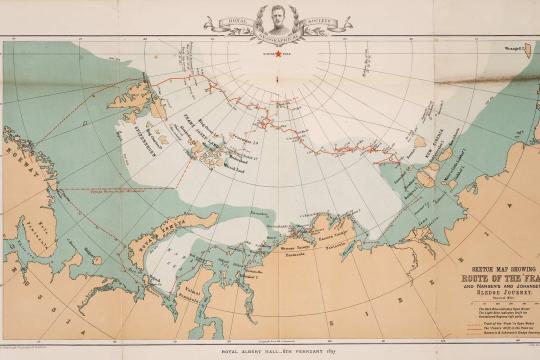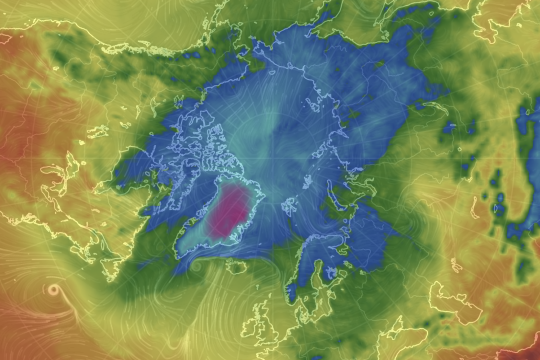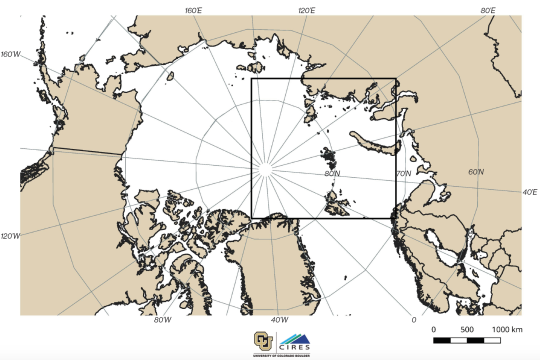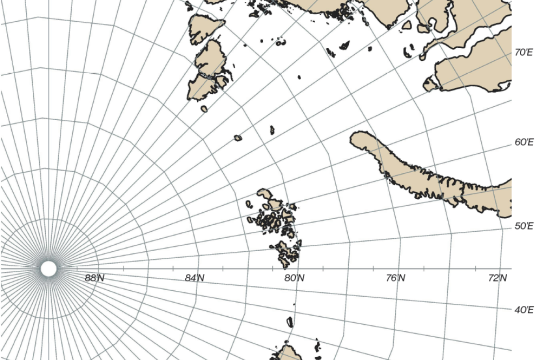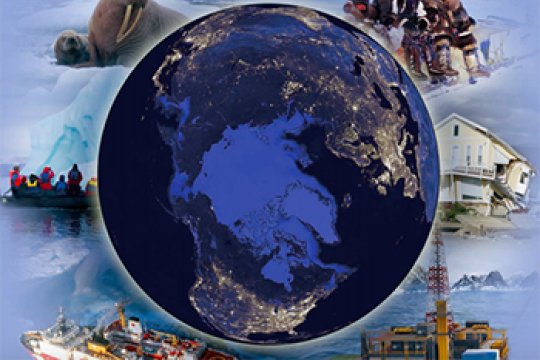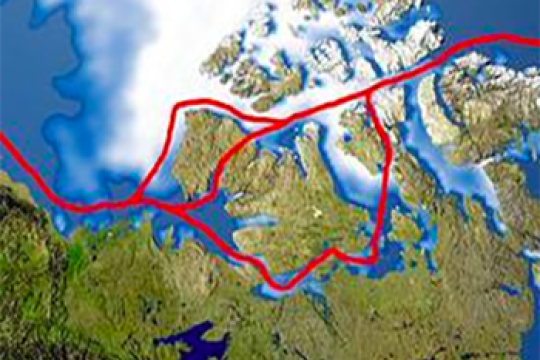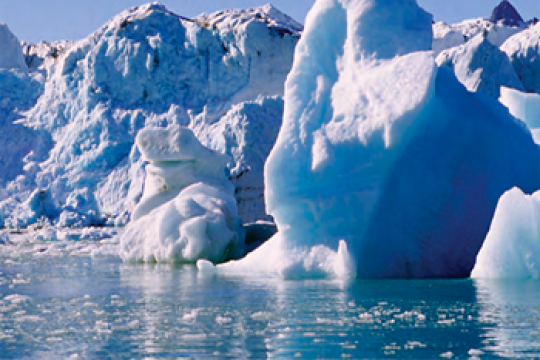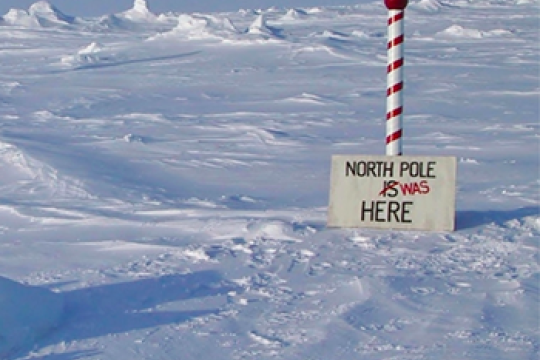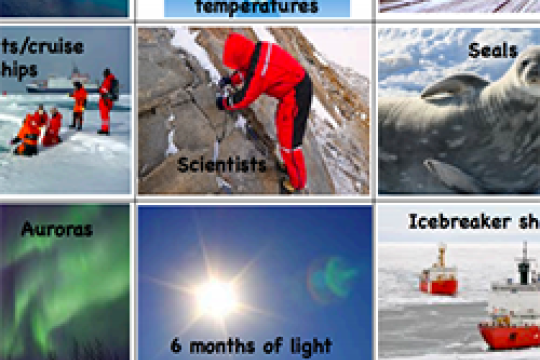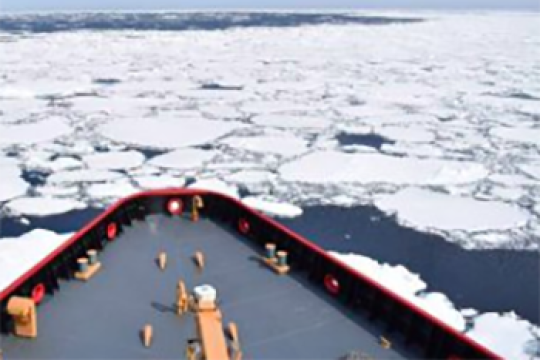Geography
Quick Bite: The Arctic vs. the World
How does the Arctic Ocean's bathymetry compare to Earth's other ocean basins? Learn more in this Quick Bite activity.
Project of Mosaic Quick bite
Subject: Earth science, Geography, mosaic monday, Oceans and ocean circulation
Grade Level: Middle School, High School
Developer: CIRES
How does the Arctic Ocean's bathymetry compare to Earth's other ocean basins? Learn more in this Quick Bite activity.
Project of Mosaic Quick bite
Subject: Earth science, Geography, mosaic monday, Oceans and ocean circulation
Grade Level: Middle School, High School
Developer: CIRES
Quick Bite: Planting a Flag in the Arctic: Not so EEZ
To claim underwater territory, coastal nations must first understand their nearshore seafloor geology. In this short activity, your students will examine maps of Arctic Ocean bathymetry and identify continental shelves of the Arctic coastal nations.
Project of Mosaic Quick bite
Subject: Earth science, Geography, Geopolitics, mosaic monday
Grade Level: Middle School, High School, University/college
Developer: CIRES
To claim underwater territory, coastal nations must first understand their nearshore seafloor geology. In this short activity, your students will examine maps of Arctic Ocean bathymetry and identify continental shelves of the Arctic coastal nations.
Project of Mosaic Quick bite
Subject: Earth science, Geography, Geopolitics, mosaic monday
Grade Level: Middle School, High School, University/college
Developer: CIRES
Quick Bite: Climate Change Impacts on Indigenous Ways of Life
Indigenous peoples have over centuries adapted to living in the harsh and rugged Arctic, but their environment is changing rapidly. How are Indigenous peoples' ways of life being threatened by a changing climate? Photo credit: Eric Keto/Alaska's Energy Desk
Project of Mosaic Quick bite
Subject: Climate, ELA, Geography, mosaic monday
Grade Level: Middle School, High School
Developer: CIRES
Indigenous peoples have over centuries adapted to living in the harsh and rugged Arctic, but their environment is changing rapidly. How are Indigenous peoples' ways of life being threatened by a changing climate? Photo credit: Eric Keto/Alaska's Energy Desk
Project of Mosaic Quick bite
Subject: Climate, ELA, Geography, mosaic monday
Grade Level: Middle School, High School
Developer: CIRES
Quick Bite: Who Lives in the Arctic?
About 4 million people live in the Arctic, 10-12% of which are Indigenous peoples with a diversity of cultures and ways of life. In this activity, your students will learn more about who lives in the Arctic using information from maps.
Project of Mosaic Quick bite
Subject: Geography, mosaic monday, Obtaining and evaluating information
Grade Level: Middle School, High School, University/college
Developer: CIRES
About 4 million people live in the Arctic, 10-12% of which are Indigenous peoples with a diversity of cultures and ways of life. In this activity, your students will learn more about who lives in the Arctic using information from maps.
Project of Mosaic Quick bite
Subject: Geography, mosaic monday, Obtaining and evaluating information
Grade Level: Middle School, High School, University/college
Developer: CIRES
Quick Bite: (Re)Defining the Arctic
There are several ways to define the Arctic region geographically. In this Quick Bite activity, students will explore how a changing climate could change these geographic definitions.
Project of Mosaic Quick bite
Subject: Climate, Constructing explanations, Earth science, Geography, mosaic monday
Grade Level: Middle School, High School, University/college
Developer: CIRES
There are several ways to define the Arctic region geographically. In this Quick Bite activity, students will explore how a changing climate could change these geographic definitions.
Project of Mosaic Quick bite
Subject: Climate, Constructing explanations, Earth science, Geography, mosaic monday
Grade Level: Middle School, High School, University/college
Developer: CIRES
Quick Bite: You're Getting Warmer...
Looking at how global temperatures have changed over time can give us valuable insight into our planet's health. In this Quick Bite activity, students watch an animation of global temperature anomalies over time to discover that something strange is going on in the Arctic.
Project of Mosaic Quick bite
Subject: Analyzing and interpreting data, Climate, Earth science, Geography, mosaic monday
Grade Level: Middle School, High School, University/college
Developer: CIRES
Looking at how global temperatures have changed over time can give us valuable insight into our planet's health. In this Quick Bite activity, students watch an animation of global temperature anomalies over time to discover that something strange is going on in the Arctic.
Project of Mosaic Quick bite
Subject: Analyzing and interpreting data, Climate, Earth science, Geography, mosaic monday
Grade Level: Middle School, High School, University/college
Developer: CIRES
Quick Bite: What is Climate?
What is climate? In this activity, your students will explore the differences between climate and weather to try to answer this question.
Project of Mosaic Quick bite
Subject: Climate, Earth science, Geography, mosaic monday
Grade Level: Middle School, High School
Developer: CIRES
What is climate? In this activity, your students will explore the differences between climate and weather to try to answer this question.
Project of Mosaic Quick bite
Subject: Climate, Earth science, Geography, mosaic monday
Grade Level: Middle School, High School
Developer: CIRES
Explore the Arctic virtually Aboard the Fram
Project of Mosaic Lesson plan
Subject: Engineering and technology, Expeditions, Geography, mosaic monday
Grade Level: Middle School, High School, University/college
Developer: CIRES
Project of Mosaic Lesson plan
Subject: Engineering and technology, Expeditions, Geography, mosaic monday
Grade Level: Middle School, High School, University/college
Developer: CIRES
Know Your Ocean: Polar Research
Learn more about polar topics like glaciers and ice sheets, Arctic sea life, and sea ice in these polar research educational modules from the Woods Hole Oceanographic Institution.
Subject: Earth science, Ecosystems, Geography, Life science, Obtaining and evaluating information, Oceans and ocean circulation, Physical science, Sea ice
Grade Level: Middle School, High School, University/college, Adult
Learn more about polar topics like glaciers and ice sheets, Arctic sea life, and sea ice in these polar research educational modules from the Woods Hole Oceanographic Institution.
Subject: Earth science, Ecosystems, Geography, Life science, Obtaining and evaluating information, Oceans and ocean circulation, Physical science, Sea ice
Grade Level: Middle School, High School, University/college, Adult
Polar Discovery: Arctic Ocean Circulation
The Arctic Ocean is a unique part of the globe, covered by ice much of the year and fairly isolated from the other oceans. Learn about how water in the Arctic Ocean moves around and why using this interactive graphic from the Woods Hole Oceanographic Institution.
Data visualization
Subject: Earth science, Geography, Obtaining and evaluating information, Oceans and ocean circulation, Physical science
Grade Level: Middle School, High School, University/college, Adult
The Arctic Ocean is a unique part of the globe, covered by ice much of the year and fairly isolated from the other oceans. Learn about how water in the Arctic Ocean moves around and why using this interactive graphic from the Woods Hole Oceanographic Institution.
Data visualization
Subject: Earth science, Geography, Obtaining and evaluating information, Oceans and ocean circulation, Physical science
Grade Level: Middle School, High School, University/college, Adult
Route of the Fram Expedition (1893-1896)
On July 5th, 1893, the Fram set sail from Tromsø, Norway to try to reach the highest latitude ever attained. Fridtjof Nansen, leader of the Fram expedition, attempted to freeze a custom-built wooden ship in sea ice and use Arctic currents to drift north. See where the Fram--and Nansen--drifted and dogsledded during their three years in the Arctic.
Project of Mosaic Data visualization
Subject: Expeditions, Geography, Oceans and ocean circulation
Grade Level: K-2, 3-5, Middle School, High School, University/college
On July 5th, 1893, the Fram set sail from Tromsø, Norway to try to reach the highest latitude ever attained. Fridtjof Nansen, leader of the Fram expedition, attempted to freeze a custom-built wooden ship in sea ice and use Arctic currents to drift north. See where the Fram--and Nansen--drifted and dogsledded during their three years in the Arctic.
Project of Mosaic Data visualization
Subject: Expeditions, Geography, Oceans and ocean circulation
Grade Level: K-2, 3-5, Middle School, High School, University/college
Fluid Earth Viewer
Explore atmospheric and oceanographic conditions in the Arctic or anywhere else on the globe with this incredible data visualization tool.
Data visualization
Subject: Analyzing and interpreting data, Atmosphere, Earth science, Geography, Oceans and ocean circulation
Grade Level: 3-5, Middle School, High School, University/college, Adult
Developer: Byrd Polar and Climate Research Center
Explore atmospheric and oceanographic conditions in the Arctic or anywhere else on the globe with this incredible data visualization tool.
Data visualization
Subject: Analyzing and interpreting data, Atmosphere, Earth science, Geography, Oceans and ocean circulation
Grade Level: 3-5, Middle School, High School, University/college, Adult
Developer: Byrd Polar and Climate Research Center
Where is the Arctic?
Have your students label and color the countries around the Arctic and do some research about the various people who live in the Arctic region. How is the 'Arctic' defined geographically? Note: We suggest using the this map in conjunction with the "Tracking the Polarstern" map (download both maps and copy them front to back for your students). The inset box on the "Where is the Arctic?" map shows the boundaries for the "Tracking the Polarstern" map.
Project of Mosaic Quick bite
Subject: Geography
Grade Level: K-2, 3-5, Middle School, High School, University/college
Developer: CIRES
Have your students label and color the countries around the Arctic and do some research about the various people who live in the Arctic region. How is the 'Arctic' defined geographically? Note: We suggest using the this map in conjunction with the "Tracking the Polarstern" map (download both maps and copy them front to back for your students). The inset box on the "Where is the Arctic?" map shows the boundaries for the "Tracking the Polarstern" map.
Project of Mosaic Quick bite
Subject: Geography
Grade Level: K-2, 3-5, Middle School, High School, University/college
Developer: CIRES
Tracking the Polarstern
The route that the Polarstern will take across the Central Arctic is not fully known. Since the ship will be frozen in the Arctic sea ice and drifting along with it wherever it goes, we can only make predictions about the path will follow. Each week we will provide you with the latitude and longitude coordinates of the Polarstern so that your students can track its journey across the Arctic in your classroom. Download this map and plot your first set of coordinates!
Project of Mosaic Quick bite
Subject: Expeditions, Geography
Grade Level: K-2, 3-5, Middle School, High School, University/college
Developer: CIRES
The route that the Polarstern will take across the Central Arctic is not fully known. Since the ship will be frozen in the Arctic sea ice and drifting along with it wherever it goes, we can only make predictions about the path will follow. Each week we will provide you with the latitude and longitude coordinates of the Polarstern so that your students can track its journey across the Arctic in your classroom. Download this map and plot your first set of coordinates!
Project of Mosaic Quick bite
Subject: Expeditions, Geography
Grade Level: K-2, 3-5, Middle School, High School, University/college
Developer: CIRES
Cold Cases: Who Won the Race to the North Pole - Cook or Peary?
Students use primary sources to conduct a mock trial to debate whether Cook or Peary was the first explorer to reach the North Pole.
Lesson plan
Subject: Arguing from evidence, ELA, Expeditions, Geography, Obtaining and evaluating information
Grade Level: High School
Developer: Ohio State University
Students use primary sources to conduct a mock trial to debate whether Cook or Peary was the first explorer to reach the North Pole.
Lesson plan
Subject: Arguing from evidence, ELA, Expeditions, Geography, Obtaining and evaluating information
Grade Level: High School
Developer: Ohio State University
Arctic SMARTIC (Strategic Management of Resources in Times of Change)
Students will build off of an introductory presentation on climate change in the Arctic to devise a strategy to manage climate change impacts on a global scale (the Arctic). After a brief synopsis on current issues and management approaches in the Arctic, students will use information based on the stakeholders and interests they've identified in readings done before class, to pinpoint areas of high interest, negotiate conflicts, and develop a sustainable, multi-stakeholder management plan for high priority areas.
Lesson plan
Subject: Arguing from evidence, ELA, Geography, Obtaining and evaluating information
Grade Level: High School, University/college
Students will build off of an introductory presentation on climate change in the Arctic to devise a strategy to manage climate change impacts on a global scale (the Arctic). After a brief synopsis on current issues and management approaches in the Arctic, students will use information based on the stakeholders and interests they've identified in readings done before class, to pinpoint areas of high interest, negotiate conflicts, and develop a sustainable, multi-stakeholder management plan for high priority areas.
Lesson plan
Subject: Arguing from evidence, ELA, Geography, Obtaining and evaluating information
Grade Level: High School, University/college
Northwest Passage
Students use Google Earth to explore changing ice conditions in the Arctic, and how these changing conditions affect shipping routes, fossil fuel extraction, geopolitics, and other Arctic issues.
Lesson plan
Subject: Analyzing and interpreting data, Climate, Geography, Geopolitics, Sea ice
Grade Level: High School, University/college
Developer: Glenn Richard, SERC
Students use Google Earth to explore changing ice conditions in the Arctic, and how these changing conditions affect shipping routes, fossil fuel extraction, geopolitics, and other Arctic issues.
Lesson plan
Subject: Analyzing and interpreting data, Climate, Geography, Geopolitics, Sea ice
Grade Level: High School, University/college
Developer: Glenn Richard, SERC
Top of the World
Students will identify, locate, outline, and map the Arctic Circle, including the countries that lie within its boundaries. Students will define the Arctic region by latitude, temperature, and tree line. Students will compare and contrast the human and environmental characteristics of the North and South Poles, the equator, and their home town.
Lesson plan
Subject: Geography
Grade Level: 3-5, Middle School
Developer: Polar Bears International
Students will identify, locate, outline, and map the Arctic Circle, including the countries that lie within its boundaries. Students will define the Arctic region by latitude, temperature, and tree line. Students will compare and contrast the human and environmental characteristics of the North and South Poles, the equator, and their home town.
Lesson plan
Subject: Geography
Grade Level: 3-5, Middle School
Developer: Polar Bears International
Story Map: How many North Poles does the Earth Have?
In this story map, learners can explore the different north poles (e.g., geographic, magnetic).
Data visualization
Subject: Earth science, Geography
Grade Level: Middle School, High School, University/college, Adult
Developer: ESRI
In this story map, learners can explore the different north poles (e.g., geographic, magnetic).
Data visualization
Subject: Earth science, Geography
Grade Level: Middle School, High School, University/college, Adult
Developer: ESRI
To the Ends of the Earth: Comparing the Arctic and Antarctic
Students sort picture cards using a Venn diagram to find similarities and differences between the Arctic and Antarctic.
NGSS Aligned Lesson plan
Subject: Earth science, Geography
Grade Level: 3-5, Middle School
Developer: U.S. Ice Drilling Program
Students sort picture cards using a Venn diagram to find similarities and differences between the Arctic and Antarctic.
NGSS Aligned Lesson plan
Subject: Earth science, Geography
Grade Level: 3-5, Middle School
Developer: U.S. Ice Drilling Program
Arctic Climate Curriculum: Exploring the Arctic
This activity introduces students to the Arctic, including different definitions of the Arctic and exploration of the Arctic environment and Arctic people. Students set out on a virtual exploration of the geography of the Arctic using Google Earth. Students go on to learn about meteorological parameters that are measured by Arctic research teams and practice the measurements in hands-on activities.
Lesson plan
Subject: Analyzing and interpreting data, Arguing from evidence, Asking questions, Computational thinking, Earth science, Geography, Life science, Obtaining and evaluating information, Physical science, Planning investigations
Grade Level: Middle School, High School, University/college
Developer: CIRES
This activity introduces students to the Arctic, including different definitions of the Arctic and exploration of the Arctic environment and Arctic people. Students set out on a virtual exploration of the geography of the Arctic using Google Earth. Students go on to learn about meteorological parameters that are measured by Arctic research teams and practice the measurements in hands-on activities.
Lesson plan
Subject: Analyzing and interpreting data, Arguing from evidence, Asking questions, Computational thinking, Earth science, Geography, Life science, Obtaining and evaluating information, Physical science, Planning investigations
Grade Level: Middle School, High School, University/college
Developer: CIRES
Jelly Critters
Students conduct research on species of gelatinous zooplankton, and learn about their importance in the Arctic food web.
Lesson plan
Subject: Climate, Ecosystems, Geography, Life science, Obtaining and evaluating information
Grade Level: 3-5, Middle School
Developer: NOAA
Students conduct research on species of gelatinous zooplankton, and learn about their importance in the Arctic food web.
Lesson plan
Subject: Climate, Ecosystems, Geography, Life science, Obtaining and evaluating information
Grade Level: 3-5, Middle School
Developer: NOAA
